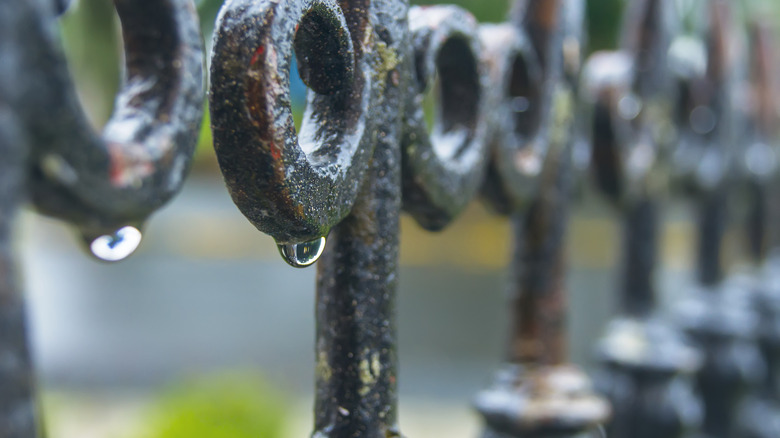Snag Historic Savannah Georgia's Breathtaking Garden Style With These Tips
Savannah, Georgia, is one of the most beautiful communities in the South, filled with 19th-century charm and historic homes perched along graceful tree-lined streets that invite exploring. Multi-story mansions dazzle in an array of brown brick and earthy neutral shades with gracefully blue ceilinged porches perfect for relaxing and afternoon cocktails. While the homes themselves are stunningly beautiful, the gardens, public or private, surrounding them can be just as striking. Often, they sport intricately lined passageways, wrought iron enclosures, ample flora and fauna, and countless spots for lingering or seeking shade from those coastal Georgia summers.
Like many southern cities in warmer climates, Savannah living undoubtedly makes these gorgeous outdoor spaces popular year-round. But you don't have to live in the South to get a similar look in your garden. We've rounded up a few things to keep in mind in your garden and outdoor space design that will have your yard, wherever you live, rivaling the most beautiful Savannah outdoor retreats.
The parterre garden
Many Savannah gardens are a variety of parterre gardens, designed to be viewed from above from veranda and pouches. Parterre gardens are a southern staple brought over from France's stylish and expansive gardens. Parterres usually contain a mix of geometric and organic shapes in the layout of planted elements, be they bushes, fountains, or flower beds. These present an overall pattern and flow to the spaces, particularly when seen from above.
As cultivated and planned as they look from above, there are also Savannah elements that speak to wildness and the unruliness of nature of southern gardens not present in the popular French origins of parterre gardens. Twisted and towering tree limbs, winding vines, Spanish moss, and other overgrown aspects balance out the more orderly designs. To get the look, design your garden to allow for both pattern and wildness, order and chaos. Consider some carefully planted beds augmented with others full of wildflower perennials or climbing wisteria.
Balancing the natural and the built environment
The southern landscape has its own collection of commonly spotted natural elements, including tall and winding crepe myrtles, magnolias, dogwood, and majestic oaks. Savannah homeowners enthusiastically incorporate these into the garden design, whether newly planted or over a century old. Rather than ripping everything out and starting anew, Savannah homeowners take full advantage of older-growth trees for all-important shade, along with ground-level and medium-height foliage for variety and privacy. Even new gardens have the feel of having been there for a century.
With the blaze of summer Georgia heat, many Savannah gardens have both an abundance of shade and a water feature, which, even at the smallest, provides a serene soundtrack for visitors. While ponds and small fountains are commonplace, larger homes and grander gardens often feature large, luxurious, sculptured water fountains. No matter how small your garden is, a water element like a fountain or koi pond can make a focal point and relaxing spot.
Secrecy and enclosure
Savannah gardens often feel like beautiful secrets when visited, many accessible through decorative side gates and wandering paths. Some are tucked completely behind carefully padlocked wrought iron gates, granting access into a lush secret world filled with bubbling water and lush, fragrant plantings like honeysuckle and gardenias. Gardens are marked by gently winding paths and well-situated seating areas that feel like little secret spots perfect for reading or conversation.
Think of your garden as a lush secret to the back or side of your property. Use things like brick retaining walls and wrought iron gates to define the space from others. Vertical elements like vine-covered arbors, gazebos, and pergolas further define and compartmentalize the space into zone and conversation nooks perfect for a bench or daybed for warm afternoon naps. Privacy is particularly a concern if you live in a busy area with close neighbors, so when planting, think about the ways that natural elements like limbs, vines, and shrubbery can create small private areas and wandering paths.
An abundance of texture
Savannah's gardens are spaces filled with texture, whether it's the greenery of plant life, bold and unfolding flowers, or the cool stone or brick of walkways. The mix of these natural elements provides a glorious appeal to all of the senses. Added stone planters, terracotta pots, and garden statues provide rich color and a ruddy, rustic layer of texture that feels centuries old.
Maximize the sense of texture in your garden by increasing the variety of materials used in your garden, including pavers, planters, and décor. Look for elements with a weathered, time-worn appeal that feels vintage or antique, even if brand new. There are also low-budget hacks for giving newer items an older look, like planters, fixtures, and more. You can also distress outdoor furniture to have an older patina and look. Antique flower pots, urns, bowls, and other objects can also be found at flea markets, antique stores, architectural salvage yards, and estate sales.
Plantings for all seasons
While Savannah's warm climate means a lack of true winter, the changing seasons can impact the look of a garden as plants grow differently throughout the seasons. An ideal Southern garden will have something exciting happening all year long and will be beautiful in any season with a mix of perennials, flowering trees, bushes, and planted annuals. Some Southern gardens are planted strategically to even be beautiful at night, including plants like night-blooming jasmine and colorful flowers that are particularly glorious when bathed by the moon.
If you plan to keep a beautiful garden all year long, whatever your climate, make sure to plant elements that will give texture and greenery well into winter, including varieties of evergreen bushes and shrubs. Think about the kinds of flowers that occur naturally in each season and what grows abundantly in your area. Add to that by making additional plantings that will keep the garden looking beautiful and thriving all year long.





